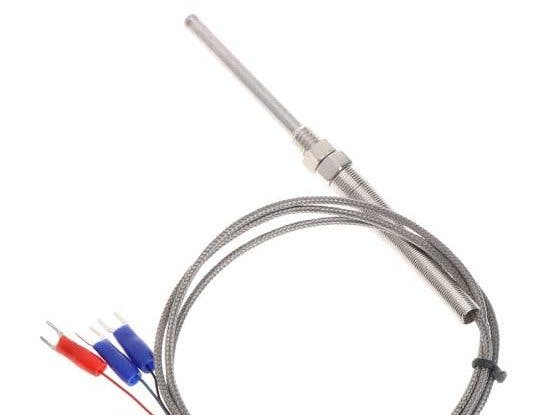Resistance Temperature Detectors (RTD) is a resistance-based temperature sensor. The most popular RTD, the PT100, use platinum and has 100 Ohm at 0 Celcius. RTD mainly consists of ceramic or glass cores wrapped around by a wire. Because of its fragile structure, usually an RTD is protected by a probe.
Compared to other sensors, RTD has the advantages of accuracy, stability, and linearity. Meanwhile, its disadvantage consists of error caused by connector wire. This error however, may be reduced by using a 3-wire or 4-wire configuration.
3-Wire ConfigurationA probe is an assembly composed of an element, a sheath, a lead wire, and a termination or connection. To measure temperature, RTD element must be connected to some sort of monitoring or control equipment. Since the temperature measurement is based on the element resistance, any other resistance (lead wire resistance, connections, etc.) added to the circuit will result in measurement error.
For this purpose, 3-wire arrangements will allow the monitoring or control equipment to factor out the unwanted lead wire resistance and other resistances that occur in the circuit. Sensors using the 3-wire construction are the most common design, found in industrial process and monitoring applications. The lead wire resistance is factored out as long as all of the lead wires have the same resistance; otherwise, errors can result.
In the image above, an RTD, symbolized as Rpt, is connected with three wires with each wire having a resistance of R1, R2, and R3. The resistance as seen from wire 3 and wire 2 is Ω1 = R2 + Rpt + R3 and the resistance seen from wire 1 and 2 is Ω2 = R1 + R2. By subtracting Ω2 from Ω1 we get the final resistance of Ω1 - Ω2 = Rpt + (R3 - R1). We can see from the equation that if wire 3 and wire 1 have the same resistance, then both value will cancel out and resulting in pure RTD resistance.
Standard RTDThere are two standards for platinum RTD: European Standard (also known as DIN or IEC) and American Standard. The European Standard is considered as the international for platinum RTD. This DIN/IEC 60751 standard requires RTD to have electric resistance of 100 Ohm at 0 Celcius and a Temperature Coefficient of Resistance (TCR) of 0.00385 from 0 to 100 Celcius.
The TCR (α) affect the resistance-temperature relationship by:
There are two resistance tolerances that are specified in DIN/IEC751 which are defined as:
After I learned the theory, I tried some practical experiments to calibrate an RTD PT100 using a 3-wire configuration. To measure the resulted resistance, I use two methods. In the first method, I measure the RTD resistance directly using an Ohm Meter. While in the second method, I run through a constant 4.6mA current source generated by a PNP Transistor and a power source of 5V. Then I measure the RTD voltage with a voltmeter.
The measurement is taken at six points from 20 to 120 Celcius. The data obtained are then regressed to create a relationship between resistance and temperature. Then I took another step and tried to measure the temperature of my fridge using the RTD.
- Result
The Ω1, Ω2, and Ω1 - Ω2 data obtained are presented as:
From the regression result above, the resistance-thermal relationship of the RTD can be defined as
From the relationship above I found the resistance 97Ohm at 0 Celcius and a TCR of 0.00515
Second MethodThe measured voltage between two wires is divided by the current 4.6mA to find its corresponding resistance.
From the regression result above, the resistance-thermal relationship of the RTD can be defined as
This method also shows the resistance of 97Ohm at 0 Celcius but with a TCR of 0.00463
Although not exact, both of the results came pretty close to the reference value.
- Testing it out
Now that I found the resistance-temperature relationship of the sensor, I tried to measure the temperature of my fridge. Reading the resistance from both methods gives me the value 93 and 91.23 Ohms. Calculating the temperature gives 8 and 12.82 Celcius.
- Conclusion
The two methods used to calibrate the RTD PT100 temperature sensor manage to measure temperature. The obtained 0 Celcius and TCR values came pretty close to the reference sheet where the second method gives the closest approximation. With the obtained parameters it also manages to measure an unknown temperature.











Comments
Please log in or sign up to comment.